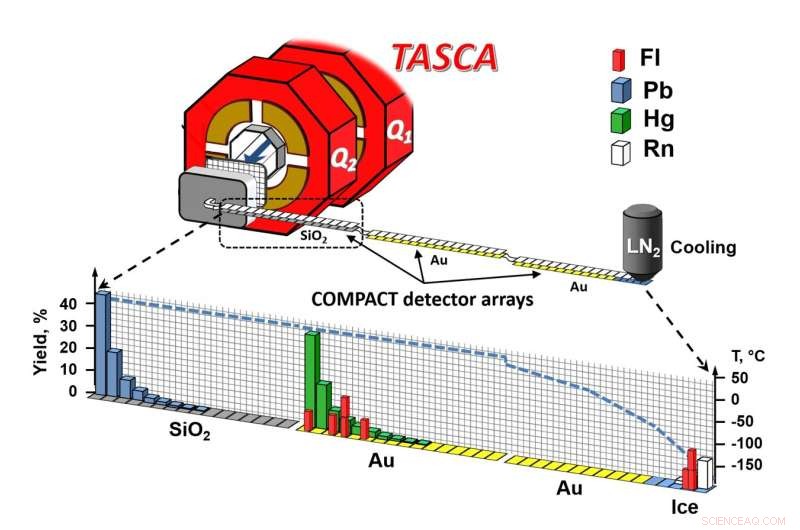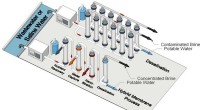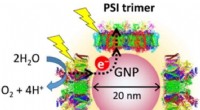Undersøgelse viser, at flerovium er det mest flygtige metal i det periodiske system

Skematisk visning af eksperimentopsætning. Kredit:A. Yakushev, GSI/FAIR
Et internationalt forskerhold fik ny indsigt i de kemiske egenskaber af det supertunge grundstof flerovium - grundstof 114 - ved acceleratorfaciliteterne i GSI Helmholtzzentrum für Schwerionenforschung i Darmstadt. Målingerne viser, at flerovium er det mest flygtige metal i det periodiske system. Flerovium er således det tungeste grundstof i det periodiske system, der er blevet kemisk undersøgt.
Med resultaterne offentliggjort i tidsskriftet Grænser i kemi , GSI bidrager til studiet af supertunge grundstoffers kemi og åbner nye perspektiver for den internationale facilitet FAIR (Facility for Antiproton and Ion Research), som i øjeblikket er under opførelse.
Under ledelse af grupper fra Darmstadt og Mainz blev de to længstlevende flerovium-isotoper, der i øjeblikket er kendt, flerovium-288 og flerovium-289, produceret ved hjælp af acceleratorfaciliteterne på GSI/FAIR og blev kemisk undersøgt ved TASCA-forsøgsopsætningen. I det periodiske system er flerovium placeret under tungmetalblyet.
Imidlertid havde tidlige forudsigelser postuleret, at relativistiske virkninger af den høje ladning i kernen af det supertunge element på dets valenselektroner ville føre til ædelgaslignende adfærd, mens nyere snarere havde foreslået en svag metallisk adfærd. To tidligere udførte kemieksperimenter, et af dem på GSI i Darmstadt i 2009, førte til modstridende fortolkninger.
Mens de tre atomer, der blev observeret i det første eksperiment, blev brugt til at udlede ædelgaslignende adfærd, viste dataene opnået ved GSI metallisk karakter baseret på to atomer. De to eksperimenter var ikke i stand til klart at fastslå karakteren. De nye resultater viser, at flerovium som forventet er inert, men i stand til at danne stærkere kemiske bindinger end ædelgasser, hvis forholdene er passende. Flerovium er derfor det mest flygtige metal i det periodiske system.
Flerovium er således det tungeste kemiske grundstof, hvis karakter er blevet undersøgt eksperimentelt. Med bestemmelsen af de kemiske egenskaber bekræfter GSI/FAIR deres førende position inden for forskning af supertunge grundstoffer.
"At udforske grænserne for det periodiske system har været en søjle i forskningsprogrammet på GSI siden begyndelsen og vil være det på FAIR i fremtiden. Det faktum, at nogle få atomer allerede kan bruges til at udforske de første grundlæggende kemiske egenskaber, hvilket giver en indikation af, hvordan større mængder af disse stoffer ville opføre sig, er fascinerende og mulig takket være den kraftfulde acceleratorfacilitet og ekspertisen i det verdensomspændende samarbejde," siger professor Paolo Giubellino, videnskabelig administrerende direktør for GSI og FAIR. "Med FAIR bringer vi universet ind i laboratoriet og udforsker stofets grænser, også for de kemiske elementer."
Seks ugers eksperimenter
Forsøgene udført på GSI/FAIR for at klarlægge fleroviums kemiske natur varede i alt seks uger. For this purpose, four trillion calcium-48 ions were accelerated to ten percent of the speed of light every second by the GSI linear accelerator UNILAC and fired at a target containing plutonium-244, resulting in the formation of a few flerovium atoms per day.
The formed flerovium atoms recoiled from the target into the gas-filled separator TASCA. In its magnetic field, the formed isotopes, flerovium-288 and flerovium-289, which have lifetimes on the order of a second, were separated from the intense calcium ion beam and from byproducts of the nuclear reaction. They penetrated a thin film, thus entering the chemistry apparatus, where they were stopped in a helium/argon gas mixture.
This gas mixture flushed the atoms into the COMPACT gas chromatography apparatus, where they first came into contact with silicon oxide surfaces. If the bond to silicon oxide was too weak, the atoms were transported further, over gold surfaces—first those kept at room temperature, and then over increasingly colder ones, down to about –160 °C.
The surfaces were deposited as a thin coating on special nuclear radiation detectors, which registered individual atoms by spatially resolved detection of the radioactive decay. Since the decay products undergo further radioactive decay after a short lifetime, each atom leaves a characteristic signature of several events from which the presence of a flerovium atom can unambiguously be inferred.
One atom per week for chemistry
"Thanks to the combination of the TASCA separator, the chemical separation and the detection of the radioactive decays, as well as the technical development of the gas chromatography apparatus since the first experiment, we have succeeded in increasing the efficiency and reducing the time required for the chemical separation to such an extent that we were able to observe one flerovium atom every week," explains Dr. Alexander Yakushev of GSI/FAIR, the spokesperson for the international experiment collaboration.
Six such decay chains were found in the data analysis. Since the setup is similar to that of the first GSI experiment, the newly obtained data could be combined with the two atoms observed at that time and analyzed together.
None of the decay chains appeared within the range of the silicon oxide-coated detector, indicating that flerovium does not form a substantial bond with silicon oxide. Instead, all were transported with the gas into the gold-coated portion of the apparatus within less than a tenth of a second.
The eight events formed two zones:a first in the region of the gold surface at room temperature, and a second in the later part of the chromatograph, at temperatures so low that a very thin layer of ice covered the gold, so that adsorption occurred on ice.
From experiments with lead, mercury and radon atoms, which served as representatives of heavy metals, weakly reactive metals as well as noble gases, it was known that lead forms a strong bond with silicon oxide, while mercury reaches the gold detector. Radon even flies over the first part of the gold detector at room temperature and is only partially retained at the lowest temperatures. Flerovium results could be compared with this behavior.
Apparently, two types of interaction of a flerovium species with the gold surface were observed. The deposition on gold at room temperature indicates the formation of a relatively strong chemical bond, which does not occur in noble gases. On the other hand, some of the atoms appear never to have had the opportunity to form such bonds and have been transported over long distances of the gold surface, down to the lowest temperatures.
This detector range represents a trap for all elemental species. This complicated behavior can be explained by the morphology of the gold surface:it consists of small gold clusters, at the boundaries of which very reactive sites occur, apparently allowing the flerovium to bond. The fact that some of the flerovium atoms were able to reach the cold region indicates that only the atoms that encountered such sites formed a bond, unlike mercury, which was retained on gold in any case.
Thus, the chemical reactivity of flerovium is weaker than that of the volatile metal mercury. The current data cannot completely rule out the possibility that the first deposition zone on gold at room temperature is due to the formation of flerovium molecules. It also follows from this hypothesis, though, that flerovium is chemically more reactive than a noble gas element.
The exotic plutonium target material for the production of the flerovium was provided in part by Lawrence Livermore National Laboratory (LLNL), U.S.. In the Department of Chemistry's TRIGA site at Johannes Gutenberg University Mainz (JGU), the material was electrolytically deposited onto thin titanium foils fabricated at GSI/FAIR.
"There is not much of this material available in the world, and we are fortunate to have been able to use it for these experiments that would not otherwise be possible," said Dr. Dawn Shaughnessy, head of the Nuclear and Chemical Sciences Division at LLNL. "This international collaboration brings together skills and expertise from around the world to solve difficult scientific problems and answer long-standing questions, such as the chemical properties of flerovium."
"Our accelerator experiment was complemented by a detailed study of the detector surface in collaboration with several GSI departments as well as the Department of Chemistry and the Institute of Physics at JGU. This has proven to be key to understanding the chemical character of flerovium. As a result, the data from the two earlier experiments are now understandable and compatible with our new conclusions," says Christoph Düllmann, professor of nuclear chemistry at JGU and head of the research groups at GSI and at the Helmholtz Institute Mainz (HIM), a collaboration between GSI and JGU.
How the relativistic effects affect its neighbors, the elements nihonium (element 113) and moscovium (element 115), which have also only been officially recognized in recent years, is the subject of subsequent experiments. Initial data have already been obtained as part of the FAIR Phase 0 program at GSI. Furthermore, the researchers expect that significantly more stable isotopes of flerovium exist, but these have not yet been found. However, the researchers now already know that they can expect to find a metallic element. + Udforsk yderligere
Nuclear physicist's voyage toward a mythical island
 Varme artikler
Varme artikler
-
 Forskere udvikler genbrug til kulfiberkompositterWashington State University professor Jinwen Zhang med sit forskergruppe for genbrug af kulfiber. Kredit:Washington State University Et WSU -forskerhold har for første gang udviklet en lovende måd
Forskere udvikler genbrug til kulfiberkompositterWashington State University professor Jinwen Zhang med sit forskergruppe for genbrug af kulfiber. Kredit:Washington State University Et WSU -forskerhold har for første gang udviklet en lovende måd -
 Membran kan bedre behandle spildevand, genvinde værdifulde ressourcerForskere foreslår, at nuværende afsaltningsprocesser og fremtidige hybride bruger en blokpolymermembran til at behandle ukonventionelle vandkilder. Kredit:University of Notre Dame billede/Yizhou Zhang
Membran kan bedre behandle spildevand, genvinde værdifulde ressourcerForskere foreslår, at nuværende afsaltningsprocesser og fremtidige hybride bruger en blokpolymermembran til at behandle ukonventionelle vandkilder. Kredit:University of Notre Dame billede/Yizhou Zhang -
 Ny nanodeenhed kan bruge solenergi til at producere brintSkematisk visning af et PSI-GNP-PSII-konjugat designet i denne undersøgelse. Elektronacceptor og donorsider af PSII- og PSI -komplekser, henholdsvis, er knyttet til en BNP gennem (His) 6 tags og Ni-ni
Ny nanodeenhed kan bruge solenergi til at producere brintSkematisk visning af et PSI-GNP-PSII-konjugat designet i denne undersøgelse. Elektronacceptor og donorsider af PSII- og PSI -komplekser, henholdsvis, er knyttet til en BNP gennem (His) 6 tags og Ni-ni -
 Kortlægning af ændringer i vandmolekylers dynamik og struktur i nærheden af opløste stofferMartina Havenith har hurtigt implementeret den første forskningsidé, som hun ønskede at realisere med midler fra en prestigefyldt bevilling fra Det Europæiske Forskningsråd. Kredit:RUB, Marquard K
Kortlægning af ændringer i vandmolekylers dynamik og struktur i nærheden af opløste stofferMartina Havenith har hurtigt implementeret den første forskningsidé, som hun ønskede at realisere med midler fra en prestigefyldt bevilling fra Det Europæiske Forskningsråd. Kredit:RUB, Marquard K
- Hvordan dyrkes Penicillin til et Science Project
- Hvad er en matematisk ekspression?
- Forskere identificerer protein, der kan have eksisteret, da livet begyndte
- Forsker finder et matematisk mønster i menneskelig konflikt ved hjælp af datavidenskab
- Fanget på fersk gerning:Nøgle kemiske mellemprodukter i forurenende-til-brændstof-reaktion identi…
- I verdens hovedstad for vaniljeproduktion, næsten tre ud af fire landmænd siger, at de ikke har no…


